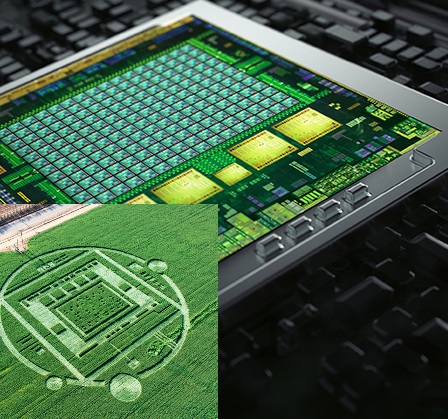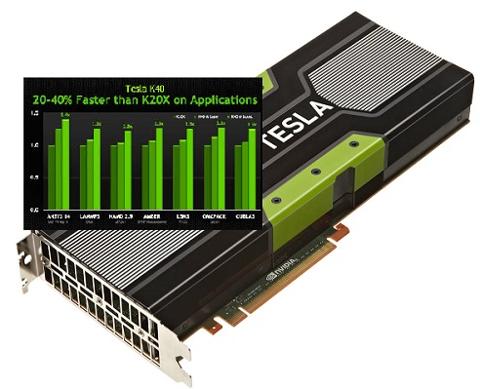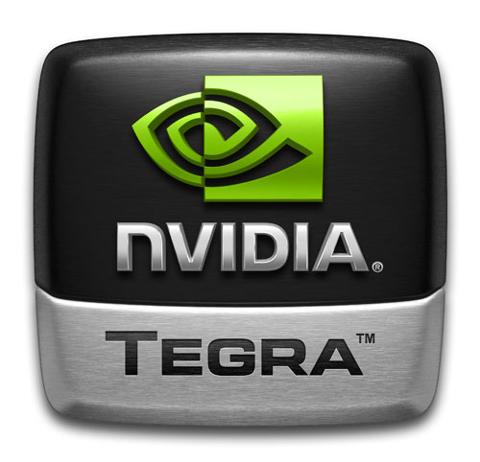 Nvidia's "super" Tegra K1 CPU and the crop circle stunt/omen of its coming.[/caption] It's never good when the CEO of a big tech firm starts out a big product introduction by admitting "This is a confession," as Nvidia chief Jen-Hsun Huang did last night. Luckily for Nvidia customers, the only thing Huang needed to get off his chest was responsibility for the crop circle that popped up in a farmer's field near Salinas, Calif. Dec. 30, 2013. The circle, which looked far more like a microprocessor of terrestrial origin, featured the numbers "192" carved several times into the center, according to a Jan. 2 analysis from un-alarmed alien watchers at RealUFOs.net. The crop circle was a marketing stunt promoting the Jan. 5 announcement of Nvidia's new Tegra K1 mobile processor, which Huang pitched as a combination of supercomputing and high-performance graphical processing, and which contains 192 cores based on the company's parallel-processing Kepler architecture. (Video available here.) Previous versions of Tegra contained only four cores. The crop circle was the result of a challenge Huang issued to the Tegra K1 launch team to find a way to get "global reach" for the message that the Tegra is so "impossibly advanced, it's practically built by aliens," with no budget at all for a special event beyond those planned for this week's Computer Electronics Show (CES) in Las Vegas. Nvidia's site admits hiring "some of the world's best crop circle artists" to carve the crop circle, as well as to distributing to local news outlets copies of a video in which the circle was "discovered." Focus of the 8 p.m. press conference did eventually drift around to specifics about the chip itself, which Huang described as a combination of the technology in the Kepler graphics cores of its GeForce graphics cards and the Tesla GPUs designed to function as performance-accelerators for CPUs in supercomputers. Nvidia is introducing both 32- and 64-bit versions of the chip. The 32-bit edition of Tegra K1 will be released during the first half of 2014 with a quad-core 4-plus-1 ARM Cortex A15 CPU, supports DirectX 11, OpenGL4.4 and tesselation, but is designed to run on mobile devices running Android. It will also be built into camera-based advanced driver-assistance systems (ADAS) in Android-enabled car systems designed to help drivers spot pedestrians, warn of blind-spot obstructions, recognize street signs and use a dashboard-mounted camera to watch for signs the driver may be falling asleep or being distracted by something other than driving. The automotive version of Tegra K1 will ship to automakers, including Audi, and to OEMs as a visual-computing module (VCM) able to run operating systems including QNX, Android, Linux and Windows. Drivers and firmware for the system can be downloaded via wireless network. Initial versions will ship at clock speeds of 2.3GHz, 8GB of memory, support both DDR3L and LPDDR3 memory and support display resolutions as high as 3840x216 for LCDs and 4K (4096x2160) on HDMI. Its symmetric multiprocessing design includes the ability to assign four performance cores to a particular task to increase speeds in bursts, and to offload cores as demand slackens to save power. It is the first mobile GPU Nvidia has designed with the CUDA parallel-processing GPU architecture, according to the company. A 64-bit version code-named "Denver" is based on the power-conserving ARMv8 architecture and will run both single- and multi-threaded applications. It is due to ship during the second half of 2014. Nvidia's announcement was the first major product announcement/publicity stunt from a major vendor at this year's edition of the Consumer Electronics Show (CES), which will run Jan. 7-10 in Las Vegas. The Tegra crop circle, by the way, was carved into the Chualar, Calif. the night of Dec. 30, while owner Scott Anthony was out of town, and was plowed under Dec. 31, according to a story from local TV news outlet KSBW's Michelle Imperato. Image: Nvida
Nvidia's "super" Tegra K1 CPU and the crop circle stunt/omen of its coming.[/caption] It's never good when the CEO of a big tech firm starts out a big product introduction by admitting "This is a confession," as Nvidia chief Jen-Hsun Huang did last night. Luckily for Nvidia customers, the only thing Huang needed to get off his chest was responsibility for the crop circle that popped up in a farmer's field near Salinas, Calif. Dec. 30, 2013. The circle, which looked far more like a microprocessor of terrestrial origin, featured the numbers "192" carved several times into the center, according to a Jan. 2 analysis from un-alarmed alien watchers at RealUFOs.net. The crop circle was a marketing stunt promoting the Jan. 5 announcement of Nvidia's new Tegra K1 mobile processor, which Huang pitched as a combination of supercomputing and high-performance graphical processing, and which contains 192 cores based on the company's parallel-processing Kepler architecture. (Video available here.) Previous versions of Tegra contained only four cores. The crop circle was the result of a challenge Huang issued to the Tegra K1 launch team to find a way to get "global reach" for the message that the Tegra is so "impossibly advanced, it's practically built by aliens," with no budget at all for a special event beyond those planned for this week's Computer Electronics Show (CES) in Las Vegas. Nvidia's site admits hiring "some of the world's best crop circle artists" to carve the crop circle, as well as to distributing to local news outlets copies of a video in which the circle was "discovered." Focus of the 8 p.m. press conference did eventually drift around to specifics about the chip itself, which Huang described as a combination of the technology in the Kepler graphics cores of its GeForce graphics cards and the Tesla GPUs designed to function as performance-accelerators for CPUs in supercomputers. Nvidia is introducing both 32- and 64-bit versions of the chip. The 32-bit edition of Tegra K1 will be released during the first half of 2014 with a quad-core 4-plus-1 ARM Cortex A15 CPU, supports DirectX 11, OpenGL4.4 and tesselation, but is designed to run on mobile devices running Android. It will also be built into camera-based advanced driver-assistance systems (ADAS) in Android-enabled car systems designed to help drivers spot pedestrians, warn of blind-spot obstructions, recognize street signs and use a dashboard-mounted camera to watch for signs the driver may be falling asleep or being distracted by something other than driving. The automotive version of Tegra K1 will ship to automakers, including Audi, and to OEMs as a visual-computing module (VCM) able to run operating systems including QNX, Android, Linux and Windows. Drivers and firmware for the system can be downloaded via wireless network. Initial versions will ship at clock speeds of 2.3GHz, 8GB of memory, support both DDR3L and LPDDR3 memory and support display resolutions as high as 3840x216 for LCDs and 4K (4096x2160) on HDMI. Its symmetric multiprocessing design includes the ability to assign four performance cores to a particular task to increase speeds in bursts, and to offload cores as demand slackens to save power. It is the first mobile GPU Nvidia has designed with the CUDA parallel-processing GPU architecture, according to the company. A 64-bit version code-named "Denver" is based on the power-conserving ARMv8 architecture and will run both single- and multi-threaded applications. It is due to ship during the second half of 2014. Nvidia's announcement was the first major product announcement/publicity stunt from a major vendor at this year's edition of the Consumer Electronics Show (CES), which will run Jan. 7-10 in Las Vegas. The Tegra crop circle, by the way, was carved into the Chualar, Calif. the night of Dec. 30, while owner Scott Anthony was out of town, and was plowed under Dec. 31, according to a story from local TV news outlet KSBW's Michelle Imperato. Image: Nvida Nvidia Uses Crop Circle to Launch 'Supercomputing' GPU
[caption id="attachment_15821" align="aligncenter" width="448"] Nvidia's "super" Tegra K1 CPU and the crop circle stunt/omen of its coming.[/caption] It's never good when the CEO of a big tech firm starts out a big product introduction by admitting "This is a confession," as Nvidia chief Jen-Hsun Huang did last night. Luckily for Nvidia customers, the only thing Huang needed to get off his chest was responsibility for the crop circle that popped up in a farmer's field near Salinas, Calif. Dec. 30, 2013. The circle, which looked far more like a microprocessor of terrestrial origin, featured the numbers "192" carved several times into the center, according to a Jan. 2 analysis from un-alarmed alien watchers at RealUFOs.net. The crop circle was a marketing stunt promoting the Jan. 5 announcement of Nvidia's new Tegra K1 mobile processor, which Huang pitched as a combination of supercomputing and high-performance graphical processing, and which contains 192 cores based on the company's parallel-processing Kepler architecture. (Video available here.) Previous versions of Tegra contained only four cores. The crop circle was the result of a challenge Huang issued to the Tegra K1 launch team to find a way to get "global reach" for the message that the Tegra is so "impossibly advanced, it's practically built by aliens," with no budget at all for a special event beyond those planned for this week's Computer Electronics Show (CES) in Las Vegas. Nvidia's site admits hiring "some of the world's best crop circle artists" to carve the crop circle, as well as to distributing to local news outlets copies of a video in which the circle was "discovered." Focus of the 8 p.m. press conference did eventually drift around to specifics about the chip itself, which Huang described as a combination of the technology in the Kepler graphics cores of its GeForce graphics cards and the Tesla GPUs designed to function as performance-accelerators for CPUs in supercomputers. Nvidia is introducing both 32- and 64-bit versions of the chip. The 32-bit edition of Tegra K1 will be released during the first half of 2014 with a quad-core 4-plus-1 ARM Cortex A15 CPU, supports DirectX 11, OpenGL4.4 and tesselation, but is designed to run on mobile devices running Android. It will also be built into camera-based advanced driver-assistance systems (ADAS) in Android-enabled car systems designed to help drivers spot pedestrians, warn of blind-spot obstructions, recognize street signs and use a dashboard-mounted camera to watch for signs the driver may be falling asleep or being distracted by something other than driving. The automotive version of Tegra K1 will ship to automakers, including Audi, and to OEMs as a visual-computing module (VCM) able to run operating systems including QNX, Android, Linux and Windows. Drivers and firmware for the system can be downloaded via wireless network. Initial versions will ship at clock speeds of 2.3GHz, 8GB of memory, support both DDR3L and LPDDR3 memory and support display resolutions as high as 3840x216 for LCDs and 4K (4096x2160) on HDMI. Its symmetric multiprocessing design includes the ability to assign four performance cores to a particular task to increase speeds in bursts, and to offload cores as demand slackens to save power. It is the first mobile GPU Nvidia has designed with the CUDA parallel-processing GPU architecture, according to the company. A 64-bit version code-named "Denver" is based on the power-conserving ARMv8 architecture and will run both single- and multi-threaded applications. It is due to ship during the second half of 2014. Nvidia's announcement was the first major product announcement/publicity stunt from a major vendor at this year's edition of the Consumer Electronics Show (CES), which will run Jan. 7-10 in Las Vegas. The Tegra crop circle, by the way, was carved into the Chualar, Calif. the night of Dec. 30, while owner Scott Anthony was out of town, and was plowed under Dec. 31, according to a story from local TV news outlet KSBW's Michelle Imperato. Image: Nvida
Nvidia's "super" Tegra K1 CPU and the crop circle stunt/omen of its coming.[/caption] It's never good when the CEO of a big tech firm starts out a big product introduction by admitting "This is a confession," as Nvidia chief Jen-Hsun Huang did last night. Luckily for Nvidia customers, the only thing Huang needed to get off his chest was responsibility for the crop circle that popped up in a farmer's field near Salinas, Calif. Dec. 30, 2013. The circle, which looked far more like a microprocessor of terrestrial origin, featured the numbers "192" carved several times into the center, according to a Jan. 2 analysis from un-alarmed alien watchers at RealUFOs.net. The crop circle was a marketing stunt promoting the Jan. 5 announcement of Nvidia's new Tegra K1 mobile processor, which Huang pitched as a combination of supercomputing and high-performance graphical processing, and which contains 192 cores based on the company's parallel-processing Kepler architecture. (Video available here.) Previous versions of Tegra contained only four cores. The crop circle was the result of a challenge Huang issued to the Tegra K1 launch team to find a way to get "global reach" for the message that the Tegra is so "impossibly advanced, it's practically built by aliens," with no budget at all for a special event beyond those planned for this week's Computer Electronics Show (CES) in Las Vegas. Nvidia's site admits hiring "some of the world's best crop circle artists" to carve the crop circle, as well as to distributing to local news outlets copies of a video in which the circle was "discovered." Focus of the 8 p.m. press conference did eventually drift around to specifics about the chip itself, which Huang described as a combination of the technology in the Kepler graphics cores of its GeForce graphics cards and the Tesla GPUs designed to function as performance-accelerators for CPUs in supercomputers. Nvidia is introducing both 32- and 64-bit versions of the chip. The 32-bit edition of Tegra K1 will be released during the first half of 2014 with a quad-core 4-plus-1 ARM Cortex A15 CPU, supports DirectX 11, OpenGL4.4 and tesselation, but is designed to run on mobile devices running Android. It will also be built into camera-based advanced driver-assistance systems (ADAS) in Android-enabled car systems designed to help drivers spot pedestrians, warn of blind-spot obstructions, recognize street signs and use a dashboard-mounted camera to watch for signs the driver may be falling asleep or being distracted by something other than driving. The automotive version of Tegra K1 will ship to automakers, including Audi, and to OEMs as a visual-computing module (VCM) able to run operating systems including QNX, Android, Linux and Windows. Drivers and firmware for the system can be downloaded via wireless network. Initial versions will ship at clock speeds of 2.3GHz, 8GB of memory, support both DDR3L and LPDDR3 memory and support display resolutions as high as 3840x216 for LCDs and 4K (4096x2160) on HDMI. Its symmetric multiprocessing design includes the ability to assign four performance cores to a particular task to increase speeds in bursts, and to offload cores as demand slackens to save power. It is the first mobile GPU Nvidia has designed with the CUDA parallel-processing GPU architecture, according to the company. A 64-bit version code-named "Denver" is based on the power-conserving ARMv8 architecture and will run both single- and multi-threaded applications. It is due to ship during the second half of 2014. Nvidia's announcement was the first major product announcement/publicity stunt from a major vendor at this year's edition of the Consumer Electronics Show (CES), which will run Jan. 7-10 in Las Vegas. The Tegra crop circle, by the way, was carved into the Chualar, Calif. the night of Dec. 30, while owner Scott Anthony was out of town, and was plowed under Dec. 31, according to a story from local TV news outlet KSBW's Michelle Imperato. Image: Nvida
 Nvidia's "super" Tegra K1 CPU and the crop circle stunt/omen of its coming.[/caption] It's never good when the CEO of a big tech firm starts out a big product introduction by admitting "This is a confession," as Nvidia chief Jen-Hsun Huang did last night. Luckily for Nvidia customers, the only thing Huang needed to get off his chest was responsibility for the crop circle that popped up in a farmer's field near Salinas, Calif. Dec. 30, 2013. The circle, which looked far more like a microprocessor of terrestrial origin, featured the numbers "192" carved several times into the center, according to a Jan. 2 analysis from un-alarmed alien watchers at RealUFOs.net. The crop circle was a marketing stunt promoting the Jan. 5 announcement of Nvidia's new Tegra K1 mobile processor, which Huang pitched as a combination of supercomputing and high-performance graphical processing, and which contains 192 cores based on the company's parallel-processing Kepler architecture. (Video available here.) Previous versions of Tegra contained only four cores. The crop circle was the result of a challenge Huang issued to the Tegra K1 launch team to find a way to get "global reach" for the message that the Tegra is so "impossibly advanced, it's practically built by aliens," with no budget at all for a special event beyond those planned for this week's Computer Electronics Show (CES) in Las Vegas. Nvidia's site admits hiring "some of the world's best crop circle artists" to carve the crop circle, as well as to distributing to local news outlets copies of a video in which the circle was "discovered." Focus of the 8 p.m. press conference did eventually drift around to specifics about the chip itself, which Huang described as a combination of the technology in the Kepler graphics cores of its GeForce graphics cards and the Tesla GPUs designed to function as performance-accelerators for CPUs in supercomputers. Nvidia is introducing both 32- and 64-bit versions of the chip. The 32-bit edition of Tegra K1 will be released during the first half of 2014 with a quad-core 4-plus-1 ARM Cortex A15 CPU, supports DirectX 11, OpenGL4.4 and tesselation, but is designed to run on mobile devices running Android. It will also be built into camera-based advanced driver-assistance systems (ADAS) in Android-enabled car systems designed to help drivers spot pedestrians, warn of blind-spot obstructions, recognize street signs and use a dashboard-mounted camera to watch for signs the driver may be falling asleep or being distracted by something other than driving. The automotive version of Tegra K1 will ship to automakers, including Audi, and to OEMs as a visual-computing module (VCM) able to run operating systems including QNX, Android, Linux and Windows. Drivers and firmware for the system can be downloaded via wireless network. Initial versions will ship at clock speeds of 2.3GHz, 8GB of memory, support both DDR3L and LPDDR3 memory and support display resolutions as high as 3840x216 for LCDs and 4K (4096x2160) on HDMI. Its symmetric multiprocessing design includes the ability to assign four performance cores to a particular task to increase speeds in bursts, and to offload cores as demand slackens to save power. It is the first mobile GPU Nvidia has designed with the CUDA parallel-processing GPU architecture, according to the company. A 64-bit version code-named "Denver" is based on the power-conserving ARMv8 architecture and will run both single- and multi-threaded applications. It is due to ship during the second half of 2014. Nvidia's announcement was the first major product announcement/publicity stunt from a major vendor at this year's edition of the Consumer Electronics Show (CES), which will run Jan. 7-10 in Las Vegas. The Tegra crop circle, by the way, was carved into the Chualar, Calif. the night of Dec. 30, while owner Scott Anthony was out of town, and was plowed under Dec. 31, according to a story from local TV news outlet KSBW's Michelle Imperato. Image: Nvida
Nvidia's "super" Tegra K1 CPU and the crop circle stunt/omen of its coming.[/caption] It's never good when the CEO of a big tech firm starts out a big product introduction by admitting "This is a confession," as Nvidia chief Jen-Hsun Huang did last night. Luckily for Nvidia customers, the only thing Huang needed to get off his chest was responsibility for the crop circle that popped up in a farmer's field near Salinas, Calif. Dec. 30, 2013. The circle, which looked far more like a microprocessor of terrestrial origin, featured the numbers "192" carved several times into the center, according to a Jan. 2 analysis from un-alarmed alien watchers at RealUFOs.net. The crop circle was a marketing stunt promoting the Jan. 5 announcement of Nvidia's new Tegra K1 mobile processor, which Huang pitched as a combination of supercomputing and high-performance graphical processing, and which contains 192 cores based on the company's parallel-processing Kepler architecture. (Video available here.) Previous versions of Tegra contained only four cores. The crop circle was the result of a challenge Huang issued to the Tegra K1 launch team to find a way to get "global reach" for the message that the Tegra is so "impossibly advanced, it's practically built by aliens," with no budget at all for a special event beyond those planned for this week's Computer Electronics Show (CES) in Las Vegas. Nvidia's site admits hiring "some of the world's best crop circle artists" to carve the crop circle, as well as to distributing to local news outlets copies of a video in which the circle was "discovered." Focus of the 8 p.m. press conference did eventually drift around to specifics about the chip itself, which Huang described as a combination of the technology in the Kepler graphics cores of its GeForce graphics cards and the Tesla GPUs designed to function as performance-accelerators for CPUs in supercomputers. Nvidia is introducing both 32- and 64-bit versions of the chip. The 32-bit edition of Tegra K1 will be released during the first half of 2014 with a quad-core 4-plus-1 ARM Cortex A15 CPU, supports DirectX 11, OpenGL4.4 and tesselation, but is designed to run on mobile devices running Android. It will also be built into camera-based advanced driver-assistance systems (ADAS) in Android-enabled car systems designed to help drivers spot pedestrians, warn of blind-spot obstructions, recognize street signs and use a dashboard-mounted camera to watch for signs the driver may be falling asleep or being distracted by something other than driving. The automotive version of Tegra K1 will ship to automakers, including Audi, and to OEMs as a visual-computing module (VCM) able to run operating systems including QNX, Android, Linux and Windows. Drivers and firmware for the system can be downloaded via wireless network. Initial versions will ship at clock speeds of 2.3GHz, 8GB of memory, support both DDR3L and LPDDR3 memory and support display resolutions as high as 3840x216 for LCDs and 4K (4096x2160) on HDMI. Its symmetric multiprocessing design includes the ability to assign four performance cores to a particular task to increase speeds in bursts, and to offload cores as demand slackens to save power. It is the first mobile GPU Nvidia has designed with the CUDA parallel-processing GPU architecture, according to the company. A 64-bit version code-named "Denver" is based on the power-conserving ARMv8 architecture and will run both single- and multi-threaded applications. It is due to ship during the second half of 2014. Nvidia's announcement was the first major product announcement/publicity stunt from a major vendor at this year's edition of the Consumer Electronics Show (CES), which will run Jan. 7-10 in Las Vegas. The Tegra crop circle, by the way, was carved into the Chualar, Calif. the night of Dec. 30, while owner Scott Anthony was out of town, and was plowed under Dec. 31, according to a story from local TV news outlet KSBW's Michelle Imperato. Image: Nvida 

